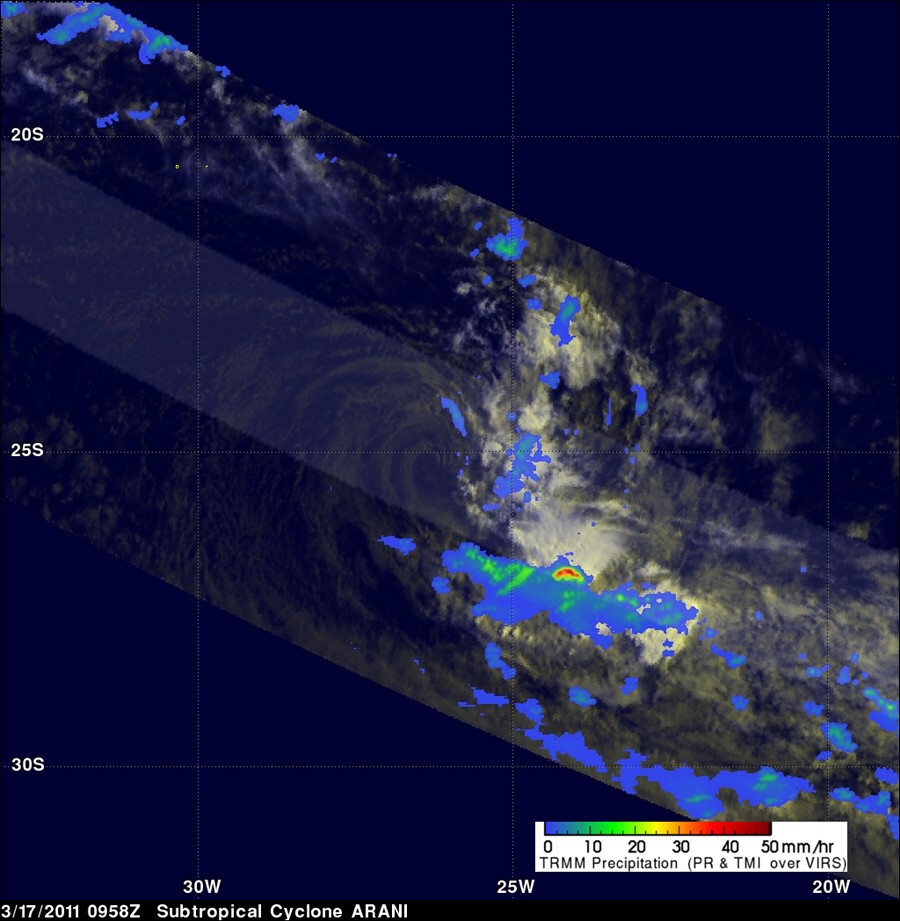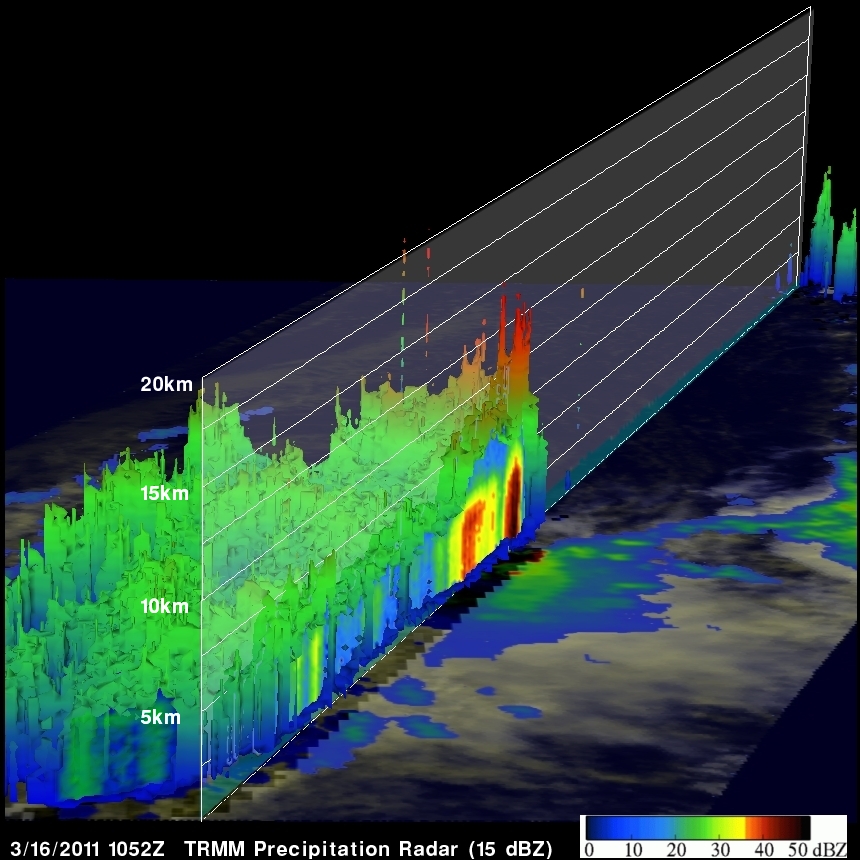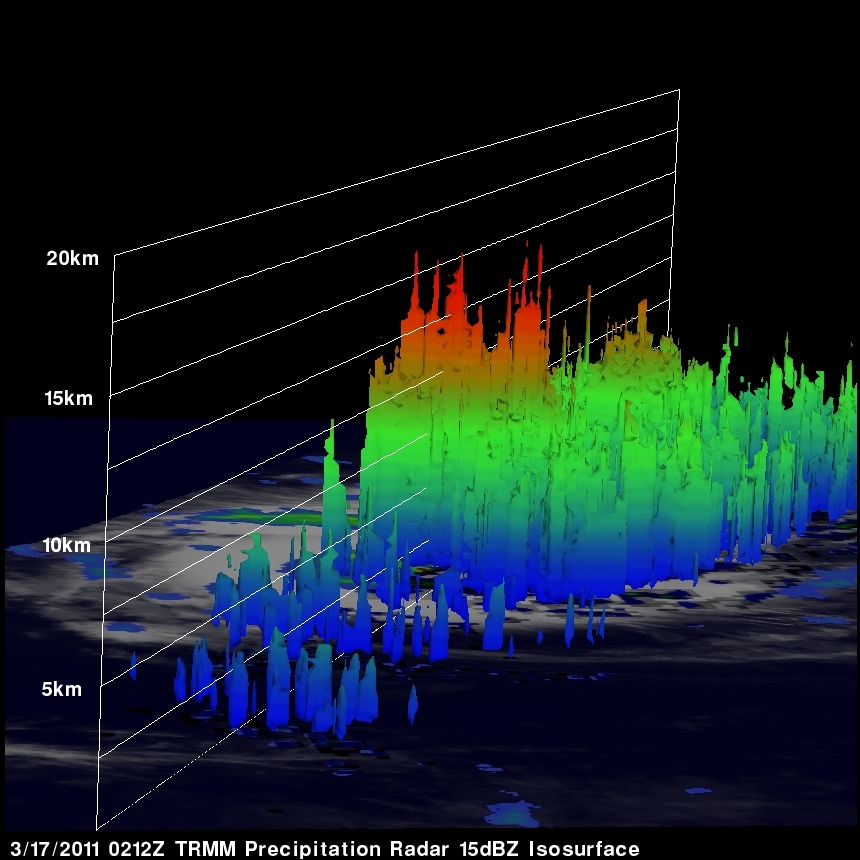Southern Atlantic Subtropical storm Arani information

NASA’s Aqua and TRMM satellites are providing data to scientists about the Southern Atlantic Ocean Sub-tropical Storm Arani, a rare occurrence in the southern ocean. Rainfall data and cloud top temperatures revealed some heavy rain and strong thunderstorms exist in Arani as it continues to pull away from Brazil. NOAA’s Satellite and Information Service classified Arani as a T1 on the Dvorak intensity scale which would indicate an estimated wind speed of about 29 knots (~33 mph).

Storm contained mostly moderate rainfall, falling at a rate between 20 and 40 millimeters (.89 to 1.57 inches) per hour. However, there were some areas of heavy rainfall in the north and eastern quadrants of the storm. The heavier rainfall was occurring at about 50 mm or 2 inches per hour. TRMM’s Microwave Imager (TMI) and Precipitation Radar (PR) data were used in the image above to show rainfall near Arani.
On Mar. 16 satellite flew over storm system and took its temperature. NASA’s Aqua satellite captured an infrared image of Sub-Tropical Storm Arani’s cold thunderstorm cloud tops in two areas of the storm. The Atmospheric Infrared Sounder (AIRS) instrument that flies aboard Aqua provided infrared readings of those cloud tops and showed that they were as cold as or colder than -63F/-52 C, and were areas of heavy rainfall. The strongest thunderstorms wrapped from the north, eastward to the south of the center of circulation, confirming the data from the TRMM satellite. Later the TRMM satellite again passed over Sub-Tropical Storm Arani and noticed it still had some strong thunderstorms and was producing heavy rainfall off the Brazilian coast.

TRMM data was used to create a 3-D view of Sub-tropical Storm Arani’s clouds, and it showed that there were very heavy thunderstorms in the eastern half of the storm. Some of these powerful storms were reaching to heights of over 14 km (~8.7 miles) above the surface of the Southern Atlantic Ocean.
Arani has the appearance of a tropical cyclone but has been classified as a subtropical cyclone. Subtropical cyclones are low pressure areas that develop with a cold core and transition to a warm core in the mid-levels of the troposphere, resembling a tropical cyclone. They more typically form outside of hurricane season (which is June 1 to Nov. 30 in the Northern Atlantic, for example). They also have broad wind patterns and that means that their maximum sustained winds are usually located farther from the center than a tropical cyclone. They also have no weather fronts linked to them, such as a typical low pressure area that brings summertime storms with an associated cold front. Subtropical cyclones can sometimes become tropical cyclones, and occasionally, tropical cyclones can become subtropical.

Tropical cyclones are very rare in the Southern Atlantic Ocean. In 2004 a cyclone called Catarina formed in the South Atlantic and caused some controversy when it was classified as a hurricane by the United States’ National Hurricane Center.
Arani is over the open waters of the Southern Atlantic and continues to move east-southeast and farther away from Brazil.

Tropical Rainfall Measuring Mission (TRMM)
TRMM’s Microwave Imager (TMI)
NOAA’s Satellite and Information Service
Precipitation Radar (PR)
Atmospheric Infrared Sounder (AIRS)
Aqua satellite

Commenting rules and guidelines
We value the thoughts and opinions of our readers and welcome healthy discussions on our website. In order to maintain a respectful and positive community, we ask that all commenters follow these rules.